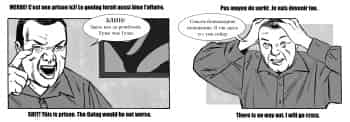Bonus
-
The Future of Comics in the Web Ara – Part III
Digital publication can be an opportunity to realign the value readers give to comic books and to broaden traditional readership. “Interestingly the survey did indicate that 57% of the digital readers did read print comics, while just 16% of the print readers had purchased or read digital comics. Also of interest are the top reasons that readers preferred one format or the other. Digital readers preferred reading comics digitally because they provided immediate access (which could mean that many of these readers don’t have access to a convenient comic shop), and they also like the convenience and easy storage and portability of digital comics.)” (“DC Retailer Survey Results: Older, Male, Middle-class, Avid,” comicsbeat.com, February 10, 2012). This indicates that the digital and physical markets reach two relatively different groups of readers. But this is no reason to fear the new medium.
Neil Gaiman explains that he first became interested in artwork piracy on the Web when he was looking into the issue of violations of his own copyright. He quickly realized something strange: sales increased in areas where his comics were being pirated. For example, his work is most pirated in Russia but that’s also where they have the highest sales.
Intrigued, he convinced his publisher to experiment by making one of his most popular comics, American Gods, which has consistently good sales, available for free on the Internet for one month. Sales of the series increased 300%. (« Neil Gaiman explique son point de vue sur le piratage », www.comicsblog.ff, August 19, 2012).
-
But what were they saying? (The Visit) – Part II
-
The Future of Comics in the Web Ara – Part II
Graeme McMillan regrets that the industry has become a niche market (“The Beauty of Digital,” www.newsarama.com, July 11, 2012). One of the reasons frequently cited for this is price. Brubaker is nostalgic for a time when comic books cost $2.99 and he thinks the price hike is a reason for declining sales (“CR Sunday Interview: Ed Brubaker,” www.comicsreporter.com, June 24, 2102). Brian K. Vaughan agrees and so he priced the first issue of the Saga series (which contained 44 pages) at $2.99 (David Uzurmeri, “Saga: Brian K. Vaughan and Fiona Staples Bring a Stellar Sci-Fi Comic into World, www.comicsalliance.com, March 14, 2012). Higher prices don’t allow consumers buy as many issues for their activity budget (“Marvel’s Axel Alonso Made Me Laugh this Morning,” www.comicsreporter.com, July 6, 2012). Between 2000 and 2010, the price of comics increased 77% in the US (“With Great Power Comes Great Financial Hardship,” www.comicboodaily.com, June 4, 2010). And on top of the higher price, many feel there is now less and less text in comics, which means they are much faster to read. That makes them very pricey for the amount of time readers get out of them (“Where Did all the Words Go?” www.comicbookdaliy.com, May 21, 2010).
Comics don’t just compete with other superhero series and manga but with other forms of entertainment. Because readers have lots of choices, it’s easy to cut part of their budget for comic books (Ed Campbell, “Are You Willing to Make a Cut,” www.comicbookdaily.com, March 24, 2012).
-
The Future of Comics in the Web Ara – Part I
There are currently several phenomena converging to change the comic-book industry. Daniel Champion pinpoints one of these in “Will the Digital Age in comics give birth to a new animal? “ (“The Digital Age,” www.comicbookdaily.com, December 13, 2011). We believe one of the top issues of the digital era should be to refocus on regularity of publication. Historically, comic books were published consistently: every month, the reader would find a new issue of his or her favourite hero. In recent years, publishers have been slacker about scheduling, and analysts wonder about the impact of this. (“Creators, Deadlines and Consistency,” www.comicbookdaily.com, November 25, 2011). The Web makes this even more important. Creating faithful readers requires discipline about publishing at a frequency that’s suitable for this new environment. As Todd Allen said, “Baldwin points out that if this is how people are reading the content in digital format, maybe the 20-22 page comic isn’t the way to go online. The science of branding is all about repetition. If you want to get people into the habit of buying your comic, Baldwin reckons it will take 6-8 touches to make someone a fan, so it might make more sense to release 8 pages 3 x a month (almost weekly) or maybe 5 pages each week. (“How Many Pages of a Digital Comic Get Read in One Sitting?” comicsbeat.com, February 24, 2012).
-
But what were they saying? (The Visit) – Part I






